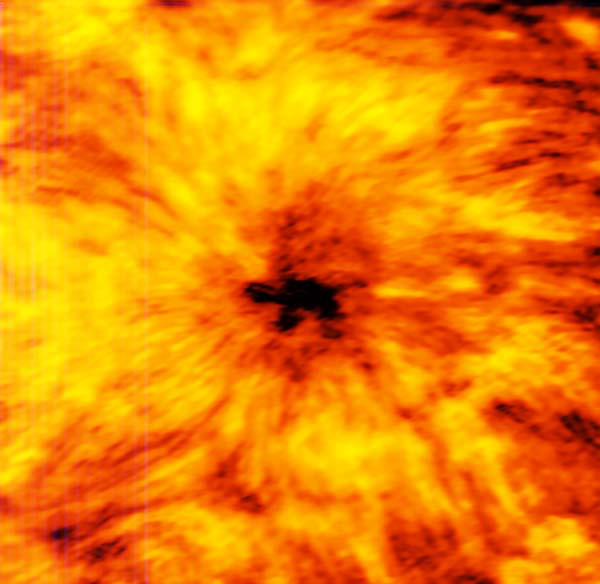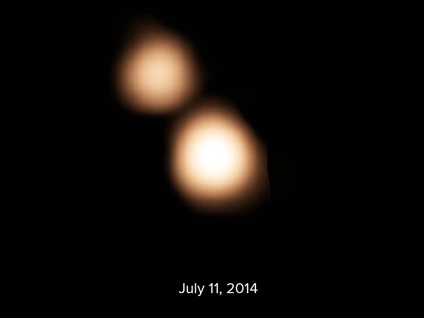Solar System
ALMA has explored the Solar System from its small cold distant bodies, to its planets and moons, and to the Sun, resulting in sensitive high resolution images of their surfaces and atmospheres.
Sun
ALMA has developed the ability to image solar activity at longer wavelengths than observed with typical solar telescopes on Earth. These observations provide an important expansion of the range of observations that can be used to probe the physics of the Sun. Since the Sun is many billions of times brighter than the faint objects ALMA typically observes, the solar commissioning team developed special procedures to enable ALMA to safely image the Sun.
Sunspots are transient features that occur in regions where the Sun’s magnetic field is extremely concentrated and powerful. They are lower in temperature than their surrounding regions, which is why they appear relatively dark in visible light. The ALMA image is essentially a map of temperature differences in a layer of the Sun’s atmosphere known as the chromosphere, which lies just above the visible surface of the Sun (the photosphere). The chromosphere is considerably hotter than the photosphere. Understanding the heating and dynamics of the chromosphere are key areas of research that will be addressed by ALMA. Observations at shorter wavelengths probe deeper into the solar chromosphere than longer wavelengths. Hence, observations at 1.3 mm wavelength map a layer of the chromosphere that is closer to the visible surface of the Sun than 3 mm wavelength observations. Moreover, since emission from the Sun can change dramatically on short timescales, time-resolved observations with ALMA will play a key role in constraining chromospheric models.
Figure 1: ALMA 1.25 mm image of a sunspot taken on 18 December 2015.
Planets and moons
ALMA spectral line observations can probe the structure (wind, temperature, and pressure) and composition of solar system bodies. ALMA observations have already been used to trace the winds on Venus, the presence of water vapor in the Martian atmosphere, the atmospheres of Jupiter, and mapping the rings around Uranus. In bodies such as Titan, the photo- and thermo-chemistry can be monitored and the importance of outgassing and sublimation can be explored to detect seasonal abundance variations. Thermal maps of Europa have been used to look for hot or cold spots that can help locate geological activity.
Figure 2: ALMA map of Jupieter showing the distribution of ammonia gas below Jupiter’s cloud deck (de Pater et al. 2019, AJ, 158, 139).
Asteroids and Comets
ALMA’s sensitivity to millimeter radiation emitted by large and small Solar System bodies provides a measurement of their size and albedo while its high resolution enables imaging of surface properties. Comets are key objects for the study of the origin and evolution of icy materials in the Solar System. They contain the most pristine materials in the Solar System and can be used to trace the chemical conditions during the epoch of planet formation. Comets also may have been responsible for seeding the young Earth with water, organic molecules, and Phosphorus containing molecules that may have helped life to emerge on Earth. ALMA spectral line observations can measure the chemical abundances of molecular species in comets.
Dwarf planets
Pluto is the most famous dwarf planet. Thermal observations with ALMA, combined with observations at other wavelengths, help measure the sizes and masses of these objects. Spectral line observations can also probe the atmospheres, if present, such as in Pluto.
Figure 3: Animated image of ALMA data showing the motion of the moon Charon around the icy dwarf planet Pluto.
ALMA Science Highlights



